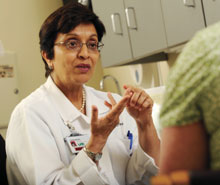Living Longer and Healthier with Cystic Fibrosis
By Gail Short
 Veena Antony and her
Veena Antony and her
colleagues offer care and
counseling to help adult CF
patients lead normal lives. Cystic fibrosis (CF) was once exclusively a child’s disease. Until the 1960s, most sufferers died before reaching grade school.
A deadly, autosomal, recessive disorder, CF causes thick, sticky mucus to clog the lungs and digestive system. Patients experience shortness of breath, wheezing, and dangerous lung infections, and their bodies have a harder time absorbing nutrients from food. But today they’re living longer, helped by advances including new drugs and nebulizers, high-fat diets, and supplements to replace digestive enzymes.
“Life expectancy has grown exponentially,” says Veena Antony, M.D., a professor in the UAB Division of Pulmonary, Allergy, and Critical Care Medicine. “Today the median is about 38 years. Some of my patients are in their 60s, and one is over 70.” For patients who outgrow pediatric CF services, UAB’s Adult Cystic Fibrosis Program helps them manage their own care.
Grown-Up Care
“Our goal is to help patients lead normal, adult lives,” says Antony, the program’s director. “Most of them do so despite having a disease that has so much disability attached to it.”
|
Patients in UAB's Adult Cystic Fibrosis Program meet with a physician, respiratory therapist, nurse practitioner, dietician, and social worker on the same day for updates on lung function, body weight, and overall health. |
Established in 2000, the program has an 11-member staff that provides comprehensive care to more than 160 patients.
When those patients visit UAB, they meet with a physician, respiratory therapist, nurse practitioner, dietician, and social worker on the same day for updates on lung function, body weight, and overall health. They also receive counseling to help them manage school, work, or major life changes that can impact their health, Antony says.
For instance, while some women with CF have lowered or decreased fertility, those who get pregnant require careful monitoring by the program’s medical team to ensure that both the mothers and the babies they’re carrying get enough nutrition. Lung infections are another risk, says Antony.
Many CF patients also survive long enough to develop diseases of aging, including diabetes and cancer, says Antony, forcing doctors to tailor treatments around CF. With diabetes, for example, patients must continue eating a high-calorie diet, unlike their non-CF counterparts. Most CF patients, however, respond well to insulin, she says.
Research Benefits
Toward New Therapies
|
The program also gives patients a direct connection to the newest CF treatments, many developed and tested at UAB, through partnerships with researcher Steven Rowe, M.D., and scientists at the UAB Gregory Fleming James Cystic Fibrosis Research Center, directed by Eric Sorscher, M.D. “Most of our patients are involved in some kind of clinical trial,” Antony says.
Several UAB researchers are testing new drugs that counteract mutations in the cystic fibrosis transmembrane conductance regulator (CFTR) gene that causes CF. Rowe is investigating ivacaftor as a potential treatment for a rare form of CF caused by a G551D gene mutation. Earlier tests have shown that the drug improves lung function and weight gain in patients. Microbiologist David Bedwell, Ph.D., is testing ataluren, which binds to cell ribosomes to overcome mutations and restore some CFTR gene function.
These and other research studies available through the adult program give patients hope for longer, healthier lives, Antony says. “It’s such a sea change,” she says. “Patients smile and talk about hanging on until the next drug discovery for their gene mutations. It’s exciting to be part of it.”
More Information
UAB Adult Cystic Fibrosis Program
UAB Gregory Fleming James Cystic Fibrosis Research Center
This story originally appeared in the summer 2012 issue of UAB Medicine, the magazine of the UAB School of Medicine.